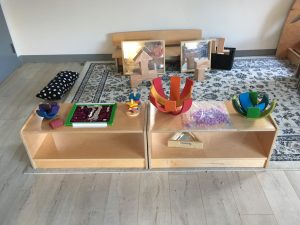Many concepts come to mind when you hear the word “Reggio”: Free play, children’s interests, open-ended questions, child led activities, etc. But what is really “Reggio Emilia”? Reggio Emilia is pedagogy (teaching theory) from the Reggio (town) of Emilia in Italy. You might wonder what does that mean and how does it relate to Canadian education? What does this mean for our children in the Cedar Room?

A provocation is set up by a Cedar Room teacher.
The concept of Reggio is one of culture; a culture collaboratively made by the children, families and Educators involved and influenced by the culture they live in. Reggio respects the uniqueness of every child in a classroom and the context of the relationships built. The educators in the Early Learning Schools of Reggio themselves say that it is impossible to recreate the Reggio education style, changes with every teacher’s interpretation, with the children and with the physical location of the centres.
It is the educators job to not stand back and do nothing, which is so often the misconception of the Reggio inspired method, but to co construct ideas and knowledge in the classroom and allow children to think independently. If done correctly Reggio inspired philosophy can be done with any stage of development, including infants. In the Mongio Infant room provocations (thought-provoking invitations) are put out by the educators to explore and support ideas. Educators follow the children’s interests and try to provide materials and activities (provocations) that can further those curiosities and challenge the children. When working with infants many people think that the lack of language becomes a barrier to explore ideas, but the vivid facial expressions and body language speak volumes. You just have to be willing to listen and adapt.


